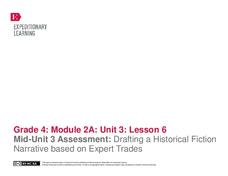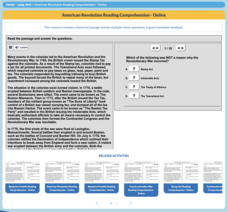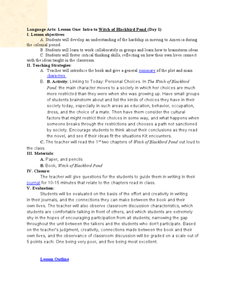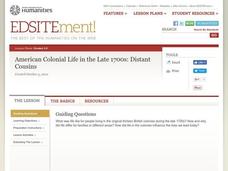Curated OER
Bartering in Jamestown
Students explore bartering. In this bartering lesson, students study everyday life in the Jamestown colony. Students discover how bartering was used as a way to acquire necessary supplies.
Curated OER
The Settlement of New England
A thorough exploration of the Puritan Migration and settlement of Plymouth, this presentation is sure to engage your young historians with its clear maps and historical documents. The presentation differentiates the philosophies of...
EngageNY
Mid-Unit 1 Assessment: Inferring with Pictures and Text
Mark the mid-point in the module with the authentic assessment described and provided here—the assessment and the unit focus on inferring using pictures and text. Pupils are given an image, a graphic organizer, and an article and must...
TPS Journal
Sourcing a Document: The First Thanksgiving
How reliable is a painting of the first Thanksgiving if it was created 300 years after the fact? Learners assess the validity of a primary source image to determine what it can actually reveal about this event.
EngageNY
Practice Planning a Historical Narrative: The Wheelwright
Fourth graders use a four-square graphic organizer to plan a paragraph writing about a wheelwright. Using gathered research from the previous unit, young writers discover how to organize a plot in preparation for writing a historical...
EngageNY
Mid-Unit 3 Assessment: Drafting a Historical Fiction Narrative Based on Expert Trades
Young historians use their planning graphic organizer to prepare a personal narrative draft on expert trades. Since the instructional activity is considered the mid-unit assessment, learners respond to a writing prompt related to the...
EngageNY
Drafting a Historical Fiction Narrative: The Wheelwright
Young writers use the four-square graphic organizer to draft their historical fiction narratives' first, second, third, and fourth paragraphs on the wheelwright. The instructional activity promotes discussion and modeling of what makes a...
EngageNY
Preparing to Write Historical Fiction: Determining Characteristics of the Genre
A language arts instructional activity helps young writers identify elements that make up historical fiction. First, it guides them through elements of fictional pieces with vocabulary cards. Then, pupils work collaboratively to...
EngageNY
Writer's Gallery and End of Unit 3 Assessment: On-Demand New Historical Fiction Narrative
Fourth-grade writers applaud their historical narrative writing pieces through a Writer's Gallery. First, they read an assigned classmate's work and leave a positive comment on a sticky note. Once learners have read a couple of people's...
NPR
Journalism Lesson Plan
Honor women in journalism with an online exhibit called Women with a Deadline. Class members demonstrate their understanding of the topic in a final assessment by writing a newspaper article on the information they learned in...
Mr. Nussbaum
American Revolution
An interactive practice challenges scholars to read an informational text and answer 10 questions. The topic of the passage is the American Revolution.
Benjamin Franklin Tercentenary
The Autobiography of Benjamin Franklin
Need a model for character education? Benjamin Franklin presents himself as in a constant state of striving to become the man he hoped to be, making his autobiography is far more accessible to learners than those of people who consider...
Curated OER
The Boston Tea Party: Costume Optional?
Students investigate the events of the Boston Tea Party. They read and analyze first-hand accounts, answer discussion questions, develop a chart of facts, and create a newspaper article, letter, or factual report.
Teacher Created Resources
The First Thanksgiving Book
Looking for a Thanksgiving week activity? Try this seven-page printable book documenting the story of the first Thanksgiving. Each page (1/2 sheet) has a short text along with a picture kids can color in.
Memorial Hall Museum
Dedham Deed
Class members examine primary source documents that expose the contrasting views of land ownership between the Pocumtuck and English settlers.
Curated OER
Intro to Witch on Blackbird Pond
Fourth graders read Witch on Blackbird Pond and understand the difficulties of traveling to America during the colonial period. In this Witch on Blackbird Pond lesson, 4th graders compare the choices we have in...
Curated OER
American Colonial Life in the Late 1700s: Distant Cousins
Students explore daily life and its influences in the late 1700s for two families in different colonies- Delaware and Massachusetts by becoming historical detectives. After gathering information from artifacts to make inferences about...
National First Ladies' Library
The First Great Awakening
Connecting social studies and American literature, students study the Great Awakening and draw comparisons between its impact on England and on parts of Colonial America. They research the lives and experiences of people who lived during...
Curated OER
Political Cartoons: Finding Point of View
Students examine political cartoons. In this colonial America lesson, students analyze political cartoons pertaining to the Stamp Act.
Curated OER
The Founding Fathers
Students discuss the basic ideas about the government of the English colonists. They identify three kinds of colonial government developed in the thirteen colonies.
Curated OER
Exploring Life in Jamestown Settlement
Third graders locate Jamestown settlement on a historical timeline and research colonial life. They name a restaurant, identify who their potential customers might be and prepare a typical colonial menu.
Curated OER
I Helped the English Settlers
In this early America worksheet, young scholars complete the sentence "I helped the English settlers because..." that is in a dialog bubble. A picture of what appears to be Pocahontas is on the page.
Curated OER
Barter Day
Fifth graders research bartering. In this bartering instructional activity, 5th graders investigate bartering as a way to trade for goods and services. Students experience bartering first hand while playing a game.
Curated OER
Colony Crops
Fifth graders determine which crops were grown in the 13 colonies depending on their climate and geography. They explore what crops are grown in the states created from the original colonies.
Other popular searches
- Life in Colonial America
- Colonial America Worksheets
- Colonial America Crossword
- Clip Art Colonial America
- Clipart Colonial America
- Colonial America Barter
- Regions of Colonial America
- Colonial American Literature
- American Colonial Government
- Colonial America Art
- Colonial America and Math
- Colonial America Homemaker























